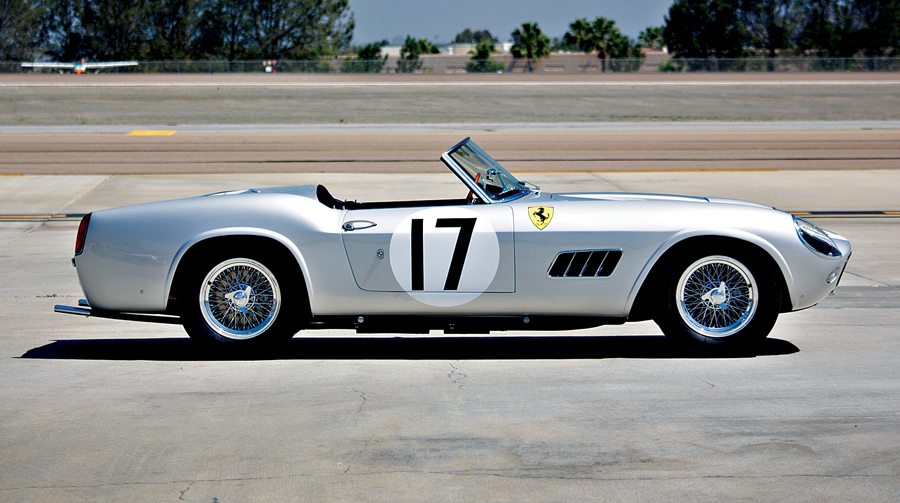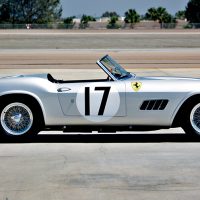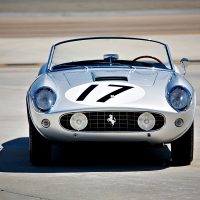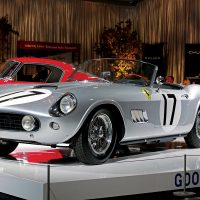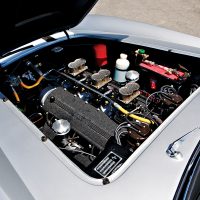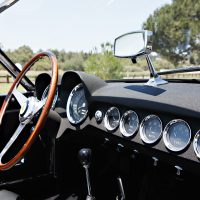The Ferrari 250 California Spyder is unquestionably among the most recognizable and beloved sports cars of all time. While the origins of the legendary model have been well established and the entire production run carefully documented by devoted historians, the exceptionally rare competition variants were built to highly individualized specifications and do not fall into a single, all-encompassing category.
By 1950s standards, all that was required to transform a California into a serious racing car was a tuned engine and a lightweight aluminum body. Only nine LWB Californias were constructed with alloy coachwork, and few of those got competition features.
Chassis 1603GT is among the last LWB Californias produced. It was the first example supplied with disc brakes. It was specified with a competition gearbox, a limited-slip differential, and an oversized 136-liter fuel tank with competition-style external fuel filler.
1603GT was also equipped with a Tipo 168 engine developed from a 250 Testa Rossa sports racing car. Just four of these engines were fitted in LWB Californias. This engine developed between 275 and 280 horsepower — approximately 50 hp more than a standard LWB California.
Throughout the late 1950s and early 1960s the car was seen at the Bahamas Speed Week and SCCA events. It also raced at the 1960 12 Hours of Sebring, where it achieved an incredible 5th Overall and 3rd in Class.
SCM Analysis
Detailing
| Vehicle: | 1959 Ferrari 250 GT California Spyder Competizione |
| Years Produced: | LWB, 1957–60 |
| Number Produced: | LWB, 42 steel cars and nine aluminum cars |
| Original List Price: | $12,000 |
| SCM Valuation: | Median to date, $8,650,000; high sale, $18,150,000 (this car) |
| Tune Up Cost: | $3,500 |
| Distributor Caps: | $550 |
| Chassis Number Location: | Left frame member by steering box |
| Engine Number Location: | Right rear motor mount |
| Club Info: | Ferrari Club of America |
| Website: | http://www.FerrariClubofAmerica.org |
| Alternatives: | 1939 Alfa Romeo 2900B Lungo Spider, 1959 Ferrari 250 TdF, 1955 Jaguar D-type |
| Investment Grade: | A |
This car, Lot 33, sold for $18,150,000, including buyer’s premium, at the Gooding & Company Pebble Beach auction on August 20, 2016.
Today it’s a little hard to picture an automobile manufacturer showcasing a car in full competition trim in their sales brochure, but that’s exactly what Ferrari did in their Ferrari 250 Granturismo berlinetta and Spyder California brochure.
The beautiful black-and-white image shows a 250 GT decked out with racing stripe and numbers traveling at speed across a gravel mountain road. Peaks of the mountain range break through dense clouds in the background, putting the location above the tree line and near the summit. The shot is from a speed event or staged to replicate the car competing in one.
Our sightings of 250 Californias and 250 berlinettas are mostly limited to the concours field today, but Ferrari clearly had other intentions for the cars. The photo showed that the 250 GT berlinetta and 250 Spyder California were bred to compete in international sports car racing. Yes, they could be driven to the grocery store, but that was incidental to the prime purpose of racing.
A world-class dual-purpose sports car
Enzo Ferrari was not interested in just competing in sports car racing — he wanted to dominate.
Using technology developed in Grand Prix racing, the company produced a series of dual-purpose sports cars that were at the top of their game for over two decades.
The 250 Spyder California and 250 Granturismo berlinetta were both scions of the 250 Tour de France, the original 250 Granturismo berlinetta.
The 250 Tour de France earned its name competing in the grueling race of the same name. The Tour de France had a 2,600-mm wheelbase (102.3 inches), which in Ferrari-speak makes it a Long Wheelbase, or LWB, model.
The 250 Granturismo berlinetta has a shorter 2,400-mm (94.5-inch) wheelbase, earning it the 250 Short Wheelbase, or SWB, name.
The prototype Spyder California was essentially a Tour de France with the top removed. The prototype used an LWB TdF chassis and TdF mechanicals. While the California evolved substantially during its production, it never lost the peaked TdF-style rear fenders, which defined its lineage.
A model in constant evolution
It would be a stretch to say no two Spyder Californias are alike, but the many production changes and available options give California collectors a lot to think about. Primarily there are LWB and SWB California models. While early Californias were built on the TdF’s 2,600-mm chassis, the later cars used the 250 SWB’s shorter 2,400-mm chassis.
Early cars had inside-plug engines, which means the spark plugs were on the inside — or carburetor side — of the heads. Later cars had improved outside-plug engines. The drum brakes of the early cars gave way to disc brakes on later examples. Telescopic shock absorbers replaced the original lever style.
California bodies were usually made in steel, but a few aluminum cars were produced.
Most Californias featured Plexiglas-covered headlights, but a few open-headlamp cars were produced. The bodies were ever-evolving, with different taillights, side vents, door handles and fog lights.
The shape of the soft tops changed during production, and an attractive hard top was available by request.
You could get bumpers or no bumpers and standard or competition gas-filler caps.
The interior did not escape the constant evolution. The spartan, competition-inspired interior of the first Californias gave way to a nicely finished space that was more in line with the California’s price than purpose.
Flat seats gave way to buckets. Crackle-painted dashes got covered in leather. Steering wheels changed, ashtrays were added, and wool carpet replaced rubber mats.
Mechanical options mixed with the evolutionary updates to give even more combinations of California configurations.
The factory brochures showed five different final drive options. You could get a standard gearbox or a ribbed competition box. Engines could be ordered in different states of tune. Add some color choices, and the possibilities get nearly endless.
Worth the money
Gooding’s sale of Spyder California 1603GT at $18,150,000 made it the 11th-most-expensive car ever sold at auction. Normally that would be big news, but $18,000,000 only made third place on the high sales of the week. However, that is the highest recorded sale of an LWB California.
Ferrari 250 Spyder Californias hold five of the top 21 spots on the list of most expensive cars to sell at auction. It wasn’t a surprise that 1603GT made the list; it would have been a surprise if it hadn’t made it.
Spyder California 1603GT is a special car, and it deserves the LWB record. It was ordered to be a race car, performed well as a race car, and has been well kept since retired. It features an aluminum body with covered headlights, high-output engine and a ribbed competition gearbox. It is a late LWB example with the desirable outside-spark-plug engine, disc brakes and deeper bucket seats.
While its competition history is thinner than suggested, taking 5th at Sebring gives it a high position on the Spyder California honor roll. It retains its original components — and has the Ferrari Classiche certificate. Except for an SWB chassis, there’s little that would make it more desirable.
There was apprehension on the part of buyers and sellers going into this year’s Monterey auctions.
Gooding’s result validated the general takeaway from Monterey Car Week — the market for great cars is still strong. The sale came in at the low end of the estimate, but it still made its bracket.
The buyer didn’t steal the car, the seller should be pleased, and the market breathed a sigh of relief. ♦
(Introductory description courtesy of Gooding & Company.)
